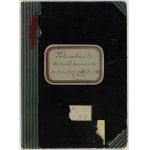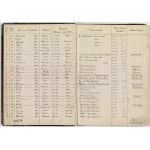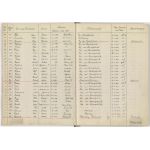Mauthausen Death Book
1939-1940
Add to Favorites:
Add all page(s) of this document to activity:

Add only page 1 to activity:
Add only page 2 to activity:
Add only page 3 to activity:
Add only page 4 to activity:
Add only page 5 to activity:
Add only page 6 to activity:
This is one of the death books from a series of original documents and copies of exhibits presented by the United States prosecuting staff in the course of trying major German war criminals under Count I (The Common Plan and Conspiracy) before the International Military Tribunal (IMT) at Nuremberg, Germany. It is in German. The cover and select pages are shown. Find the entire book in the National Archives main online catalog.
Additional details from our exhibits and publications
The Mauthausen concentration camp was a part of the Nazi killing machine responsible for 6 million deaths—almost 100,000 at Mauthausen alone. It was a complex of more than 40 labor camps spread over the eastern half of Austria and southeast Germany. Political and ideological prisoners and Jews died by “extermination through labor,” gas, shooting, starving, and beating. They came from Albania, Austria, France, Germany, Greece, Hungary, Germany, Italy, Poland, Spain, and the Soviet Union. American POWs were also held captive there. Thousands of prisoners were worked to death at the camp quarry, deaths that would be recorded for history by the prison clerks. German SS troops evacuated the camp on May 3, 1945, ahead of advancing Allied troops; and Germany surrendered to the Allies on May 7, 1945. U.S. Army investigators swept up the death books and other camp records (that were eventually transferred to the National Archives) for use at the Nuremburg Tribunal and other war crimes trials before Mauthausen was put under the jurisdiction of the Soviet Union’s Red Army in July. From 1941 to 1942, prisoner Ernst Martin had recorded the entries in the books. Martin would be especially helpful to the investigators in compiling the camp records that would be most useful at trial. Author Tomaz Jardim writes in The Mauthausen Trial: “Although Martin was ordered not to record the true causes of death, the books clearly reflect mass murder. On March 19, 1945, for instance, 275 Jewish prisoners are listed to have died of heart trouble at Mauthausen between 1:15 a.m. and 4:30 p.m. They died alphabetically, one after another, from Ackerman to Zyskind.” The SS directed Martin to destroy the books, but he took great risks to preserve them. About the death registers, Jardim writes: "More than any other piece of evidence gathered by War Crimes investigators, the death books of both Mauthausen and Gusen proved to be vital in the investigation and ultimate trial of the SS staff. These books record the deaths of near 72,000 prisoners [and] survived through the efforts of a prisoner clerk named Ernst Martin. . . . By posing as a 'dumb and disinterested clerk,' Martin gained the trust of the Nazi overlords and was put in charge of updating the death books on a daily basis." At the trial, prosecutor Lt. Col. Denson asked Martin questions about entry 2,768 in one of the death books. “Did you make any notation after the place of birth to tell you whether or not that man died an unnatural death?” Martin responded: “After the birth place, a period.” The cause of death in the book read “shot while trying to escape,” but this was a Polish Jew who was confined to a quarantine block with no opportunity to escape.
This primary source comes from the National Archives Collection of World War II War Crimes Records.
National Archives Identifier: 12060204
Full Citation: Mauthausen Death Book; 1939-1940; USA Exhibit 251; United States Exhibits , 1945 - 1946; National Archives Collection of World War II War Crimes Records, Record Group 238; National Archives at College Park, College Park, MD. [Online Version, https://www.docsteach.org/documents/document/1-mauthausen-death-book, April 20, 2024]Rights: No Known Copyright Learn more on our privacy and legal page.









